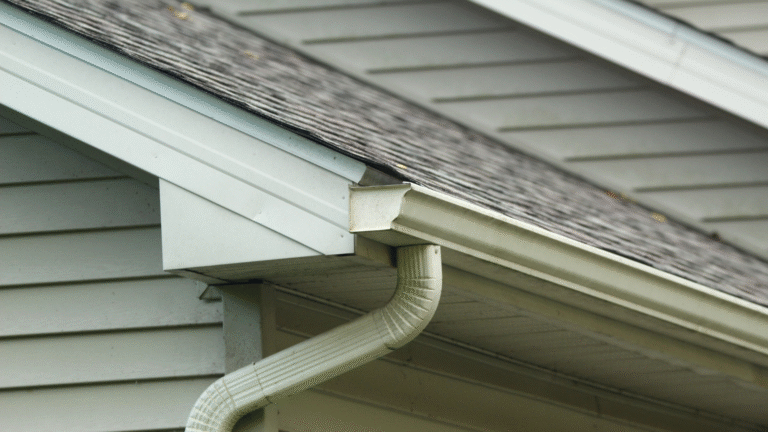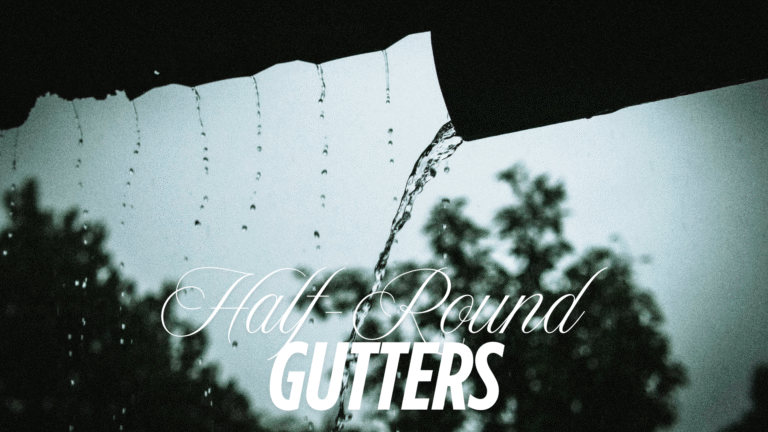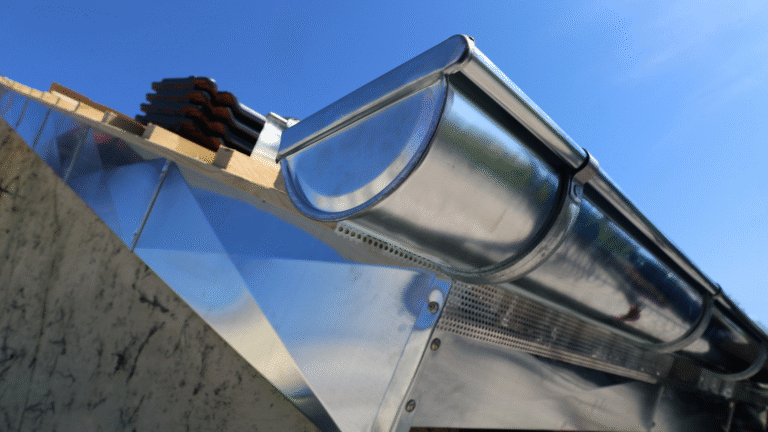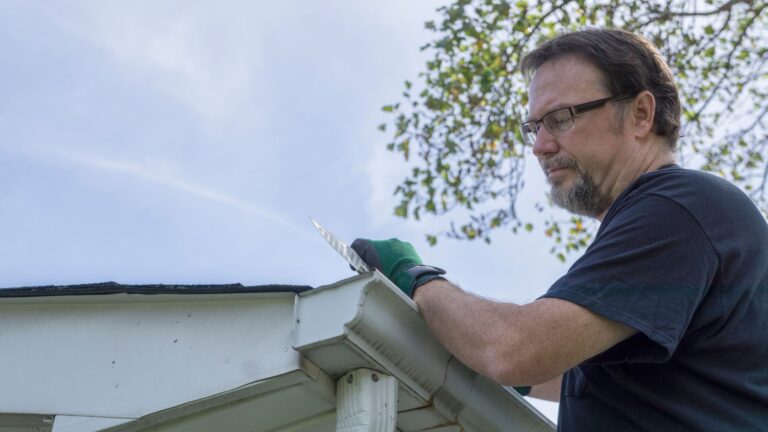The fascia board forms one of the most critical yet often overlooked parts of a roofing system. Running along the lower edge of the roof and sitting directly behind the gutters. The fascia protects your home’s structure from moisture and weather-related damage. It acts as the first line of defense against water infiltration, creating a barrier between your roof and the elements. In addition to supporting the bottom row of roof tiles. The fascia provides a sturdy base for gutter installation, allowing rainwater to drain safely away from your home. When water, pests, or aging materials damage the fascia, the entire roof system’s integrity suffers.
Without strong, intact fascia boards, water can quickly penetrate the roof decking and seep into the attic, creating conditions ripe for mold, mildew, and wood rot. Even minor fascia deterioration can escalate into expensive structural damage—a fact many homeowners overlook. By understanding the fascia’s critical function, you take the first step toward maintaining a durable, well-performing roofline. Over time, exposure to rain, snow, humidity, and fluctuating temperatures gradually wears down fascia boards. If you neglect routine maintenance, the boards may warp, crack, or rot. Especially when clogged gutters overflow or poor roofing installation traps moisture. The soffits, which connect directly to the fascia, can also break down as a result, compounding ventilation and insulation problems. Because the fascia sits at the junction between the roof and exterior walls, it plays a key role in shielding the underlying wooden framework from weather exposure.
A well-maintained fascia system helps you prevent roof leaks, sagging gutters, and even interior water damage. As climate patterns grow more unpredictable. Keeping your fascia in good condition becomes essential—not optional. In this article, you’ll learn how fascia damage develops, how to recognize early warning signs, and what can happen if you delay repairs. We’ll also explore proven prevention methods and expert repair options to help protect your home from long-term roofing issues.
What Are Fascia Boards? A Quick Overview
Fascia boards are horizontal boards mounted along the roof edge, directly beneath the roofline, and behind the gutters. Typically made from wood, PVC, vinyl, or aluminum, fascia boards serve both aesthetic and functional purposes. They provide a clean edge to the roof while acting as a structural support for gutters. Ensuring rainwater is effectively diverted from your home’s exterior walls and foundation. These boards also seal off the roof’s edge to prevent water, debris, insects, and small animals. From entering the attic or under the roof deck.
When properly installed and maintained, fascia boards can extend the life of a roof. By preventing moisture damage and improving airflow when paired with soffits. They also contribute to the home’s curb appeal by giving a clean. Finished appearance to the eaves and overhangs. However, because of their position and exposure, fascia boards are vulnerable to damage from moisture, poor drainage, or pest activity. When fascia begins to deteriorate, it can compromise the entire roof system. Understanding the core functions of fascia is key to recognizing its importance in maintaining roof integrity.
Main Roles of Fascia Boards:
Supports rain gutters and downspouts
Protects roof decking and interior spaces from moisture
Enhances the visual appeal of the roofline
Acts as a barrier against pests and rodents
Helps anchor the bottom row of roofing shingles
Provides structural stability to the roof’s edge
Seals the edge of the roof and exterior wall junction
Common Causes of Fascia Damage
Fascia boards are regularly exposed to elements that can contribute to their deterioration over time. One of the most common causes of fascia damage is prolonged moisture exposure due to clogged or overflowing gutters. When gutters become blocked with leaves, twigs, and debris, water begins to pool and back up, seeping into the fascia and causing wood rot. This constant saturation, especially if unnoticed for long periods, breaks down the board’s structural integrity. In colder climates, freeze-thaw cycles can cause fascia materials to expand and contract, leading to cracks and eventual splitting.
Additionally, improperly installed or damaged roofing systems can redirect rainwater toward the fascia, accelerating water damage. Another frequent issue is poor attic ventilation, which leads to condensation that affects not only the underside of the roof but also the inner fascia surfaces. Over time, this buildup of internal moisture further weakens the boards and shortens their lifespan.
Apart from water-related issues, pest infestations can also cause significant fascia damage. Rodents, birds, and insects like carpenter ants or termites are often attracted to moist wood and can chew, nest, or burrow into weakened fascia boards. These pests create small holes or tunnels that not only damage the fascia but also serve as entry points into the attic and roof cavity. In areas with frequent storms or high winds, flying debris and falling branches can physically damage fascia boards, leading to cracks or complete detachment.
Lastly, poor-quality building materials and lack of regular roof maintenance contribute to premature fascia failure. For instance, unpainted or untreated wood fascia is more susceptible to rotting and weathering than its sealed or composite counterparts. Recognizing the different causes of fascia deterioration is critical to implementing targeted preventive measures and ensuring your roof remains structurally sound.
Warning Signs of Damaged Fascia You Shouldn’t Ignore
Spotting early signs of fascia damage can save you from costly roof repairs down the road. Homeowners should inspect the roofline regularly and act immediately when any of these signs appear. Here are the most common warning signs that your fascia boards may be compromised:
Peeling or flaking paint on the fascia surface, especially near gutter lines
Sagging or detached gutters, which may indicate rotted or weakened fascia
Visible wood rot, cracks, or soft spots on the fascia board
Water stains or streaks running down the exterior walls beneath the roofline
Mold or mildew growth near the eaves or soffit area
Dark discoloration or patches on fascia boards indicating moisture infiltration
Pest activity, such as small burrowing holes, nests, or chew marks
Dripping water from the bottom of gutters or fascia seams during rainfall
Uneven or warped fascia boards that appear bent or misaligned
Musty odors in the attic, potentially caused by moisture entering from fascia gaps
Increased indoor humidity levels, especially near ceiling corners
Soffit ventilation blockages or signs of moisture near soffits connected to fascia
How Damaged Fascia Leads to Major Roof Problems
When fascia boards become damaged and are left unrepaired, the consequences can quickly escalate into major roofing issues. The most immediate problem is water intrusion, as the fascia serves as a protective barrier between the outside and your roof’s wooden framework. Once water seeps behind deteriorated fascia, it begins to rot the roof deck, rafters, and underlayment, weakening the entire roof structure. This kind of moisture infiltration also creates a perfect breeding ground for mold, mildew, and algae, which can spread into the attic and even interior ceilings.
Over time, the insulation in your attic may become saturated, reducing energy efficiency and increasing heating and cooling costs. Damaged fascia can also cause gutters to sag or collapse, allowing uncontrolled water runoff to damage siding, windows, and even the foundation. Additionally, ventilation problems may arise due to the soffit system being compromised, resulting in poor airflow and trapped heat in the attic.
In cold climates, ice dams can form on roof edges, forcing melted snow back under shingles and exacerbating interior water damage. Ultimately, ignoring fascia damage leads to a chain reaction of costly repairs, and in severe cases, may require a full roof replacement to restore structural integrity. Regular maintenance and early intervention are essential to protect your roof from this kind of widespread destruction.
The Ripple Effect: From Fascia Damage to Full Roof Replacement
Neglecting damaged fascia doesn’t just affect one part of your roof—it sets off a chain reaction that can ultimately result in the need for a full roof replacement. As fascia boards weaken from rot, moisture, or pest infestations, they lose their ability to support the gutters effectively. Without proper support, gutters begin to detach and sag, preventing them from channeling rainwater safely away from the house. Instead, water begins to pour over the roof’s edge and onto exterior walls, window frames, and the foundation.
Over time, this uncontrolled water flow leads to issues such as foundation cracks, basement leaks, and siding deterioration. Inside the attic, unchecked moisture from fascia damage can destroy insulation, cause wood rot in rafters, and promote mold growth that can harm your home’s air quality. In severe cases, structural framing can warp or decay, making the home unsafe and significantly reducing its value. Once this level of deterioration occurs, isolated repairs are no longer sufficient—the entire roof structure may need replacement.
Another overlooked consequence of fascia damage is the impact on overall roofing material longevity. When fascia fails to block moisture effectively, it affects the roof decking and underlayment, both of which are crucial to keeping the home dry and well-insulated. As water continues to infiltrate, shingles may begin to curl, crack, or even fall off, leading to widespread leaks and compromised roof protection. These escalating issues make it impossible to simply patch damaged areas; full roof tear-offs become necessary to remove rotted layers and rebuild the system from scratch. Additionally, homeowners may need to replace soffits, install new insulation, and address gutter replacements all at once—turning a small fascia repair into a full-blown renovation project. What starts as a few inches of rotting wood along the eaves can end in tens of thousands of dollars in restoration costs. Proactive care and early fascia repair are the best ways to avoid this domino effect and extend the lifespan of your roofing system.
Fascia vs. Soffit: Understanding the Difference and Interconnection
| Feature | Fascia | Soffit |
|---|---|---|
| Location | Runs horizontally along the edge of the roof, behind the gutters | Sits underneath the eaves, extending from the fascia to the house wall |
| Primary Function | Supports gutters and protects the roof edge from moisture and pests | Provides ventilation for attic airflow and protects the underside of the roof |
| Material Options | Wood, vinyl, aluminum, composite | Vinyl, aluminum, fiber cement |
| Vulnerability | Susceptible to rot, moisture damage, and pest infestation | Prone to mold, mildew, and ventilation blockage |
| Installation | Attached to the ends of roof trusses or rafters | Mounted beneath the fascia and overhang area |
| Repair Frequency | Medium to high if gutters overflow or water infiltrates | Medium if ventilation is poor or if water damage from fascia occurs |
| Visual Role | Gives a clean, finished edge to the roofline | Enhances curb appeal by covering exposed rafters and underside of the roof |
| Maintenance Needs | Regular inspections and paint/sealant upkeep | Must be kept clean and well-ventilated to function properly |
Fascia and soffit boards work in tandem to protect and ventilate the roof system. While fascia provides essential structural support for gutters and blocks moisture from reaching the roof deck, soffits ensure that air circulates throughout the attic, reducing condensation and keeping the roof cool. If one is damaged, the other is often affected soon after. For example, rotting fascia can allow water to seep behind and damage soffits, while blocked or moldy soffits can contribute to moisture buildup that degrades fascia boards. This interconnected relationship makes it critical to maintain both components as a single system. Understanding their differences helps homeowners spot vulnerabilities early and schedule repairs before small problems grow into widespread roof failure.
Professional Fascia Repair and Replacement Options
When fascia boards show signs of damage—whether from rot, pest activity, or water intrusion—it’s essential to consider professional repair or replacement to restore your roof’s structural integrity. In mild cases where the damage is limited to small areas, a professional contractor may opt for fascia board repair, which typically involves removing the affected section and replacing it with new, treated wood or composite material. The repaired area is then sealed and painted to match the rest of the roofline, providing a seamless look and ensuring protection against further moisture.
However, if the damage is more widespread or the material has softened significantly, full fascia replacement is often the better solution. This allows the roofing expert to inspect underlying rafters, remove rotted sections, and install high-quality, durable fascia materials that can withstand long-term exposure. Common choices include pressure-treated wood, PVC, aluminum, or fiber cement, depending on budget and climate conditions. Some homeowners also choose to upgrade their entire roofline system—including soffits and gutters—at the same time to ensure uniform protection.
Choosing a qualified roofing or exterior contractor for fascia repairs is critical, as improper installation can lead to recurring problems.
A professional will not only assess the visible damage but also inspect hidden areas, such as the connection between the fascia and soffits, and look for signs of attic condensation or deck rot. In some cases, especially with older homes, a thorough evaluation may uncover other related issues like faulty gutter pitch or inadequate attic ventilation that contributed to the fascia deterioration. Costs for fascia repair or replacement vary depending on the material, linear footage, and whether scaffolding or gutter removal is required. That said, investing in high-quality fascia repair is far more affordable than the eventual costs of neglect—such as roof leaks, structural rot, or full roof replacement. Homeowners should also ask contractors about weather-resistant coatings and moisture barriers to enhance fascia durability. Trusting a professional ensures long-term results, safety, and peace of mind when it comes to safeguarding your home’s most important defense system—your roof.
Preventive Maintenance Tips to Avoid Fascia Damage
Preventing fascia damage starts with consistent roofline maintenance and seasonal inspections. Use the following actionable tips to protect your fascia boards from moisture, pests, and premature wear:
Clean gutters at least twice a year to prevent overflow and water backflow into the fascia
Install gutter guards to reduce debris buildup and extend gutter and fascia lifespan
Inspect the fascia boards after heavy rain or storms for signs of staining, warping, or sagging
Repaint or reseal fascia boards every few years to maintain a water-resistant barrier
Ensure your roof has proper attic ventilation to reduce internal condensation and mold risk
Trim overhanging tree branches to prevent impact damage and reduce debris collection in gutters
Inspect for pest activity regularly, especially signs of termites, birds, or rodents near the eaves
Check the gutter slope and alignment to ensure water flows away smoothly from the roof edge
Replace damaged or leaking gutters promptly to avoid moisture exposure to the fascia
Use treated or moisture-resistant materials when installing or replacing fascia boards
Seal all joints and seams along the roofline to block water intrusion and pest access
Schedule annual professional roof inspections to catch minor fascia issues before they worsen
Ensure soffit vents are not blocked to maintain attic airflow and prevent internal moisture buildup
Monitor for signs of peeling paint or discoloration as early indicators of water damage
Final Thoughts:
Many homeowners overlook fascia boards when thinking about roof maintenance, but this seemingly small component plays an outsized role in protecting your home from long-term damage. Acting as a bridge between your roof and gutter system, fascia boards serve as the first line of defense against moisture infiltration, pest intrusion, and structural decay. When fascia becomes compromised—even slightly—it can start a chain reaction that affects everything from attic insulation and ventilation to the integrity of your roof deck and foundation.
Ignoring early signs of fascia damage may lead to widespread deterioration that requires costly repairs or a complete roof replacement. Conversely, proactive care—like keeping gutters clean, addressing water leaks promptly, and scheduling routine roof inspections—can keep your fascia in excellent shape and extend your roof’s lifespan by decades. As extreme weather becomes more common, taking preventative steps now can protect your home from water damage, pest infestations, and energy inefficiencies down the line.
Replacing or repairing fascia before problems worsen isn’t just a smart investment—it’s a necessary one for maintaining property value and peace of mind. In the bigger picture, maintaining strong fascia boards is a critical part of a long-lasting, weather-resistant, and structurally sound roofing system. Don’t wait until visible damage appears—prioritize fascia health as part of your regular home maintenance routine.







